Collection of materials relating to neuro-ophthalmology as part of the Neuro-Ophthalmology Virtual Education Library.
NOVEL: https://novel.utah.edu/
TO
- NOVEL231
| Title | Creator | Description | Subject | ||
|---|---|---|---|---|---|
| 176 |
 |
Indirect Ophthalmoscopy | Jonathan Micieli, MD, CM | Demonstration of using the indirect ophthalmoscope in examinations. | Indirect Ophthalmoscopy |
| 177 |
 |
Panoptic Ophthalmoscope | Amrita D. Vuppala, MD | Demonstration of using the panoptic ophthalmoscope in examinations. | Panoptic Ophthalmoscope |
| 178 |
 |
OJS Reviewer Tutorial | A. Roylance | Tutorial for testing new OJS system for reviews of NOVEL submissions. | OJS Review System |
| 179 |
 |
OJS Author Tutorial | A. Roylance | Tutorial for testing new OJS system for reviews of NOVEL submissions. | OJS Review System |
| 180 |
 |
Video Introduction to the NExT Curriculum Collection | Sachin Kedar, MD, Editor-in-Chief | Introduction to the NANOS NExT ebook. Explains the purpose of the collection. Covers the sections of the outline, and describes the learning levels and objectives. | NANOS Examination Techniques |
| 181 |
 |
Pupils Light Near Dissociation | Karl C. Golnik, MD | This narrated presentations describes light near dissociation. | Pupil; Light Near Dissociation |
| 182 |
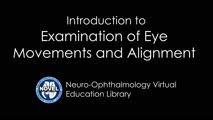 |
Examination of Eye Movements and Alignment | Jason H. Peragallo, MD | Introduction to the examination of eye movements and alignment. | Eye Movements; Alignment |
| 183 |
 |
Selective Saccadic Palsy After Cardiac Surgery | Nilan D. Schnure, MD; Ali G. Hamedani, MD, MHS; Grant T. Liu, MD | A unique gaze palsy selectively affecting saccades while sparing smooth pursuit, vergence, and vestibular reflex eye movements has been described following uncomplicated cardiac (and especially ascending aortic) surgery . This 69 year-old man reported persistent visual complaints immediately after a... | Saccade; Saccadic Palsy; Cardiac Surgery |
| 184 |
 |
Cranial Nerves: Neuroanatomy Video Lab - Brain Dissections | Suzanne S. Stensaas, PhD | The approach is to learn to associate the cranial nerves with their brainstem level and blood supply. Emphasis is given to the midbrain (3, 4), pons (5, 6, 7, 8), medulla (9, 10, 11, 12) and their most important functions. | Cranial Nerves; Brain; Dissection |
| 185 |
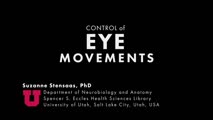 |
Control of the Eye Movements: Neuroanatomy Video Lab - Brain Dissections | Suzanne S. Stensaas, PhD | Disturbances in eye movements can provide important clues for localization of neurological damage. The role of the frontal eye fields in horizontal gaze is stressed. The need to coordinate cranial nerves on both sides of the brain stem introduces the medial longitudinal fasciculus and its role in co... | Medial Longitudinal Fasciculus; Third Cranial Nerve; Sixth Cranial Nerve; Internuclear Ophthalmoplegia; Nystagmus; Brain; Dissection |
| 186 |
 |
Comparison of the Motor Systems: Neuroanatomy Video Lab - Brain Dissections | Suzanne S. Stensaas, PhD | A comparison of the three major motor systems focuses on categorizing motor problems as corticospinal tract, cerebellar, or basal ganglia. It begins with 12 minutes of gross anatomical structures and pathway review followed by clinical video clips demonstrating clinical features of disease of each o... | Corticospinal Tract; Cerebellar; Basal Ganglia; Motor Systems; Brain; Dissection |
| 187 |
 |
Basal Ganglia: Neuroanatomy Video Lab - Brain Dissections | Suzanne S. Stensaas, PhD | Structures involved in involuntary movements are shown on models, in animations, and on gross coronal and axial sections. Diagrams show the cortex-to-cortex loop and the nigrostriatal pathway. The direct and indirect pathways are shown. The direct pathway facilitates movement while the indirect path... | Basal Ganglia; Involuntary Movements; Brain; Dissection |
| 188 |
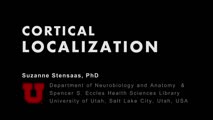 |
Cortical Localization: Neuroanatomy Video Lab - Brain Dissections | Suzanne S. Stensaas, PhD | The lobes of the brain are defined together with their major functions. The visual field representation in the occipital lobe is explained with a diagram. Speech areas and the major types of aphasia are discussed in the dominant hemisphere and parietal lesions of neglect and spatial orientation are ... | Cortical Localization; Brain; Dissections |
| 189 |
 |
Introduction: Neuroanatomy Video Lab - Brain Dissections | Suzanne S. Stensaas, PhD | The regions and lobes of the brain are identified along with some of the nerves and vessels. The basic functions of the cortex of each lobe are introduced along with principal sulci and gyri. The importance of the left hemisphere for language and the temporal lobe in memory are mentioned along with ... | Brain; Dissections |
| 190 |
 |
Brain Stem & Reflexes: Neuroanatomy Video Lab - Brain Dissections | Suzanne S. Stensaas, PhD | The cranial nerves are reviewed again on a specimen with vessels. Next, landmarks on gross brain stem sections are shown. Stressed are the three reflexes associated with each of the three levels: pupillary, corneal and gag reflexes and their associated cranial nerves. Finally cross sections of myeli... | Brain Stem; Reflexes |
| 191 |
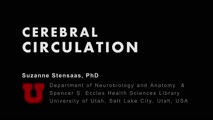 |
Cerebral Circulation: Neuroanatomy Video Lab - Brain Dissections | Suzanne S. Stensaas, PhD | The major vessels of the anterior and posterior circulation are demonstrated along with the Circle of Willis on both a model and in an animation. The distribution of the three major cerebral arteries is demonstrated along with the concept of a watershed zone. A gross specimen with good vessels is al... | Cerebral Circulation; Brain; Dissections |
| 192 |
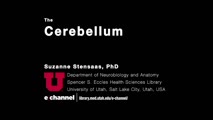 |
Cerebellum: Neuroanatomy Video Lab - Brain Dissections | Suzanne S. Stensaas, PhD | The gross features of the cerebellum are shown. The three peduncles are demonstrated, noting their input and output to and from the cerebellum. Emphasis is given to symptoms of cerebellar disease appearing on the same side of the body. Special emphasis is given to cortical-cerebellar connections, st... | Cerebellum; Cortical-Cerebellar Connection; Brain; Dissection |
| 193 |
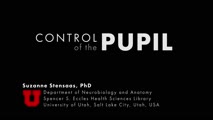 |
Control of the Pupil: Neuroanatomy Video Lab - Brain Dissections | Suzanne S. Stensaas, PhD | Through diagrams, animations and gross specimens the constriction and dilation of the pupil by the autonomic nervous system are described. Both the parasympathetic and sympathetic control are traced and the importance of a constricted pupil, Horner's Syndrome, and temporal lobe (uncal) herniation (d... | Brain; Dissections |
| 194 |
 |
Sensation from the Body: Neuroanatomy Video Lab - Brain Dissections | Suzanne S. Stensaas, PhD | Sensation consists of various modalities, which tend to travel in one of two pathways. The Anterolateral System also known as the Spinothalamic Tract carries pain and temperature. The Dorsal Column-Medical Lemniscus Pathway carries vibration, joint position, and fine 2-point discrimination. Light or... | Spinothalamic Tract; Anterolateral System; Dorsal Column-Medical Lemniscus Pathway; Body Sensation' Brain' Dissection |
| 195 |
 |
Sensation from the Face: Neuroanatomy Video Lab - Brain Dissections | Suzanne S. Stensaas, PhD | Sensation from the face travels in one of two pathways both of which eventually converge to form the trigeminothalamic tract that reaches the thalamus. The tract that carries pain and temperature is confusing because it first descends before crossing while the equivalent of Dorsal Column-Medical Lem... | Brain; Dissections |
| 196 |
 |
Vestibular System: Neuroanatomy Video Lab - Brain Dissections | Suzanne S. Stensaas, PhD | Diagrams, models and skull preparations are used to describe the vestibular apparatus. The semicircular canals, saccule and utricle are described as well as transduction by the hair cells in the ampullae and maculae. Gross material emphasizes the nerve, vestibular nuclei and connections through the ... | Vestibular; Brain; Dissection |
| 197 |
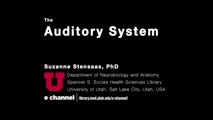 |
Auditory System: Neuroanatomy Video Lab - Brain Dissections | Suzanne S. Stensaas, PhD | The anatomy of the middle ear and cochlea are shown using models and diagrams explaining the process of air-fluid transmission and finally transduction by hair cells. Gross specimens demonstrate the cochlear nerve and its brain stem relays and crossings all the way to auditory cortex. Wernicke's are... | Middle Ear; Cochlea; Auditory Cortex; Brain; Dissection |
| 198 |
 |
The Ventricles: Neuroanatomy Video Lab - Brain Dissections | Suzanne S. Stensaas, PhD | The ventricles are demonstrated and named on a model cast as well as in rotating 3D reconstructions. The production, function, circulation and removal of CSF produced by the choroid plexus is discussed using a diagram and then reviewed on frontal, axial and sagittal brain specimens and corresponding... | Ventricles; Brain; Dissection |
| 199 |
 |
Hypothalamus: Neuroanatomy Video Lab - Brain Dissections | Suzanne S. Stensaas, PhD | Gross specimens are used to demonstrate the area of the hypothalamus and its relationship to surrounding structures. Both endocrine and autonomic functions are explored using diagrams. Mention is made of the direct hypothalamic response to circulating hormones and other substances such as sodium. Th... | Hypothalamus; Brain; Dissection |
| 200 |
 |
Three Critical Vertical Pathways: Neuroanatomy Video Lab - Brain Dissections | Suzanne S. Stensaas, PhD | There is one motor and two sensory pathways that must be mastered. Pain and temperature from the body travel together and vibration and proprioception travel in another pathway each reaching perception in the cortex. Voluntary motor control starts in the cerebral cortex and connects with a motor neu... | Spinothalamic Tract; Dorsal Column-Medical Lemniscus Pathway; Posterior Column; Vertical Pathway; Brain; Dissection |
